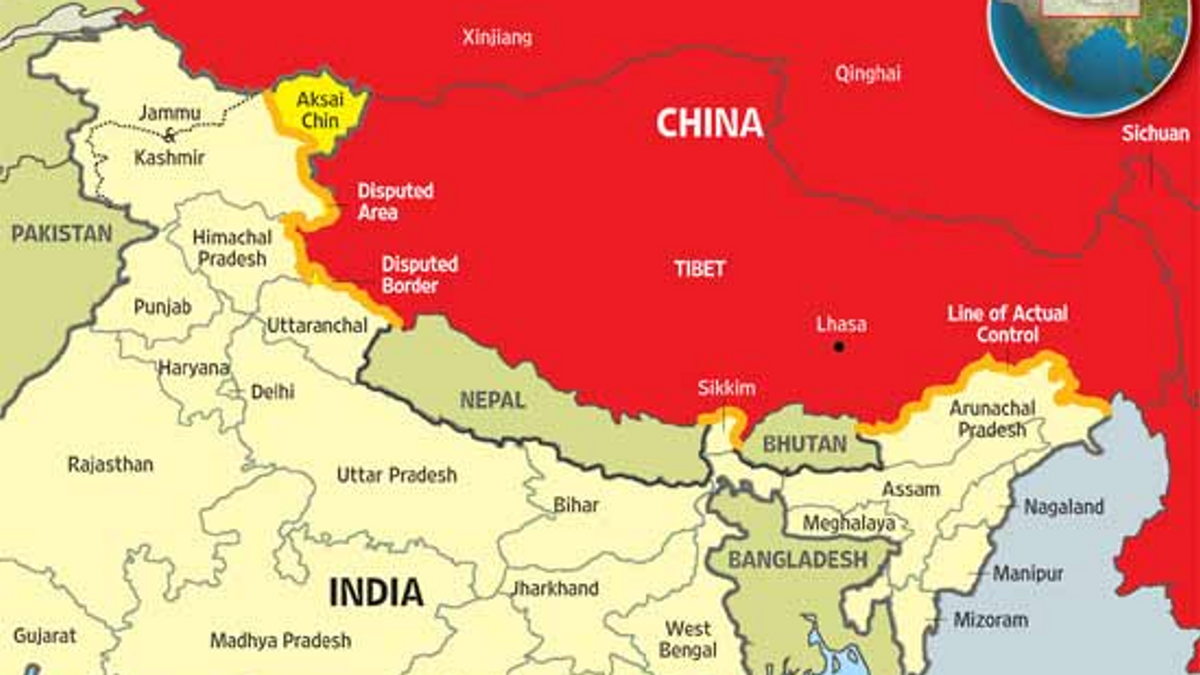
Defining the Indo-China Border
India has traditionally been having a reasonably amicable relation with its neighbours since ancient times. In the medieval period, many foreign aggressors came here essentially to prove their might and loot. Muslims were the first who came to loot, rule and spread Islam. Nepal did have a history of repeated conflict with Tibet which had very little of army. Tibet was also conquered by the Chinese but they did not occupy it. Traditionally the Tibetans had a good religious bond with Buddhist India (borderingMagadh). The border used to be ill defined till 1684 when a first Ladakh (India), Tibet, China border treaty was sign formally delineating it. The second treaty of 1842 keeping the status quo of 1684 was also signed by Maharaja of Kashmir, Dalai Lama of Tibet and the then emperor of China. German maps in 1912 by the Royal Geographical Society clearly indicating that the boundary of Sinkiang extended only up to the Khen-Lun.
In the middle sectors, there are sufficient document to prove Indian govt positionto the watershed of Sutlej on one side and the Kali, Alakhnanda and Jadh Ganga on the other till Nepal borders on east and between the tributaries of Spiti and Para Chu rivers between Tibet and the erstwhile undivided Punjab. However, there were problems in the eastern part of the boundary. British India tried to demarcate it through a tripartite agreement in 1914 Shimla agreement when the British foreign secretaryMac Mahon along with the representatives of Tibet and China drew in continuations along the highest Himalayan ridges. It is noteworthy here that Tibet was free of Qing China occupation and declared independence in early 2013. This was termed the McMahon Line. Later Chinese govt repudiated it and backed out of this agreement. The biggest failure of the British India was its failure in the late 1980s (after taking Hongkong), to compel the Chinese to withstand their commitment that demarcated the Aksai Chin and areas in NR regions as an integral part of Ladakh.
After their independence and occupation of Tibet, the Chinese drew their own map which claims many parts of India as their own. This Chinese map is in violation of all previous agreements. As the PLA became more aggressive, their troops started violating the previously agreements and increasingly started laying claims over their unilaterally drawn map and this became an often friction point. The Panchsheel agreement did not talk of the boundary and the PLA violated it with impunity that was also one of the reasons of the 1962 war. As it emerges now, lesson was not learnt by the Successive Indian govts who neglected developing the border areas as a result of which the Chinese PLA could transgress at will, with their policy of Salami Slicing. The limited conflict of 1967 was its testimony. For long, Indian govt neglected the issue and made it difficult for the Army to keep a strict vigil as there were hardly any border roads on our side. On the other hand, the PLA has developed robust roads on their sides that allow them huge mobility and strength to keep eye on us. This possibly is the reason, why they are so uncomfortable with the present govt making the border roads on priority. This is also the reasonwhy they came to object us when the bridge was being constructed on the Shyok river in the Galwan valley that finally led to the present standoff.
The present Indian govt is determined that the Chinese cannot be permitted slicing off our territories and wants the PLA to vacate all the land they have transgressedover the decades. The need of the hour is to convert the LAC in to a permanent international border which the Chinese sides have been long avoiding. Their eyes seem to be set on Mao Tse Tung’s assertion of their expansion to 5 fingers...namely Ladakh, Nepal, Bhutan, Sikkim and NEFA (now Arunachal). With Sikkim and Arunachal already secured within Indian nation, clearly their thrust is towards Ladakh. Chinese PLA kas been pushing in the eastern Ladakh ever since the 1962 war. They occupied a sizable chunk in Aksai Chin which they did not vacate after the cease-fire. They have moved inch-by-inch inside the LAC over decades, a move also known as ‘Salami slicing’. Since 2016, India has been very clearly thwarting their expansionist ambition till they were observed to have moved in the Galwan and Pangong areas in April 2020 that they are refusing to vacate which that led to the present standoff. These moves of the Chinese are clearly seen as their violation of the 1993 & 1996 agreements.
All these only reconfirm one fact...that the Chinese are not interested in demarcation of the Indo-Chinese international border. It is in their favour. Firstly, it provides them the opportunity to claim any area on the ill-defined border as disputed and start the PLA deployment. They have been declaring long stretch of Indian territories as disputed and now they have put their eyes on Bhutan too. Just the last month they have declared the Bhutan national park as disputed. Chinese consider it their birth right to start hobnobbing in theself-declared disputed zones. For the Chinese PLA a cost of few millions of dollars in the activation and deployment of troops makes no difference to their near 15 trillion-dollar economy. However,for the nations like India, Nepal or Bhutan, every such counter-deployment do make it count. Secondly, Chinese consider themselves as military superpower in the recent years. They started believing that none will oppose them militarily. Undoubtedly, they have amassed huge military assets. They however, forget the fact that military hardware does not win wars, it is the fully dedicated men behind such machines. Such dedicated manpower is a common scarcity in the PLA. Their near 20% forced recruits are highly suspect on their motivation & dedication. They were seencrying while being sent in a bus to the LAC. They will like to run away from the threat to their lives. Hence, China must accept this truth and behave as a responsible neighbour. What is the answerto it? Should India continue being drawn to the border incursions because the Chinese want it so? Indian leadership must act on it. If it is must, there is no harm in inviting an international delegation to help in the border talks. In that background, Trump’s offer may be worth considering.
